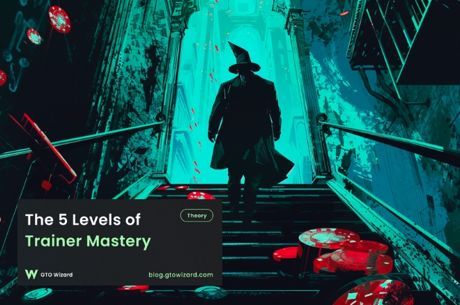Hand Review: Jack Sinclair Discusses His Crazy Bluff

Table Of Contents
Ever since he announced himself onto the live poker scene with a World Series of Poker Main Event final table run in 2017, Jack Sinclair has been a regular presence in all of this big live events around the world, including the WSOP. He showed his final table run was no fluke when he won WSOP Europe last year for over $1.2 million.
When Sinclair found himself on his latest deep run, in Event #34: $1,000 Double Stack No-Limit Hold'em, he played one of the most talked-about hands of the past few days when he executed a bluff despite what appeared to be a minimum amount of fold equity to the casual observer.
After the hand went down, PokerNews reached out to Sinclair to see if he would break it down. He agreed, and the resulting interview with PokerNews' Sarah Herring can be seen below. For those who would prefer a text-based breakdown of the hand, it's provided in this article, with all quotes courtesy of Herring and the video team.
The Scene
It's Day 3 of the $1K Double Stack and well into the money, with a couple of hundred remaining out of a field of over 6,000. There's $687,782 up top and Sinclair is grinding a decent stack of around 40 big blinds at 15,000/30,000/30,000.
The Action
According to Sinclair, action folded to him on the button where he opened for a raise with the A?10?, though he didn't specify the amount. The big blind, Bob Shao, called and 9?8?6? flopped. Both players checked. The turn was a K? and the big blind checked again. Sinclair bet half the pot, which would have been around 75,000. His opponent called, bringing the 3? river.
After a check, Sinclair bet 190,000. Shao made it 600,000, leaving only 305,000 back. Sinclair shoved all in and Shao tanked for eight minutes before releasing his hand.
Sinclair showed the bluff.
Concept and Analysis
If you're going to try to pull off a crazy bluff, you'll usually need a decent read on how your opponent in the hand plays. Sinclair provided a little bit of background, both on his opponent and on his own play, which he assumed his opponent had observed:
"My read on the guy is that he's pretty good. Tight, standard American reg. Earlier, he had seen me face a river check-shove and tank-call with a straight. I think that may have played into it."
After making a standard open, Sinclair gets a flop that brings him two overcards and a gutshot. Despite the improvement, he doesn't believe it's a good spot to fire a continuation-bet. In fact, he said he thinks it's a "pretty clear" check back due to the fact that it helps the big blind's range so often. Indeed, they'll often have at least a pair on this, if not a pair with a straight draw or a better-made hand.
The only airballs on this board are some strong Broadway combos that probably three-bet, very small pairs and suited combos of a big card and a small card that can be played out of the big blind against a single raise.
Where things start to get interesting is on the turn. Sinclair notes that he'd be betting a king for value at this point, so he opts to start bluffing. Given that his hand is unlikely to be best, he has a blocker to a straight, and he has some outs to improve on the river, it seems like a good spot to do so.
"The king is so good for my range now," he said. "I have king-queen, ace-king any traps on the flop. Ace-ten's a really good hand to bluff with. I have, first, a ten. And it's pretty low down in my check-back range when you think about it."

When Shao just calls, Sinclair feels he almost never has anything better than one pair. Most players would spring the trap at this point if they had checked a strong hand twice. So, when the river bricks off, and Shao checks, Sinclair feels he still has a decent bluffing opportunity. The pot's a little more attractive now, and his hand has no showdown value once Shao has check-called a turn bet.
Given Sinclair's read that Shao doesn't have better than one pair, a river check-raise on a brick seems mighty suspicious.
"At this point, my instinct was that he didn't have anything," Sinclair said. "I thought he was bluffing in this spot quite a lot."
The only problem? A lot of Shao's bluffs have one pair in them plus a straight blocker: hands like 7x6x, 8x7x, 10x8x, etc. Shao may feel he's lighting money on fire calling against a likely pair of kings, but he can possibly get such a hand to fold with a check-raise.
Of course, with only ace-high, Sinclair can't really bluff catch against these hands. The only options are to give it up or shove if he thinks there's still fold equity. Sinclair said he felt with 10 big blinds back, Shao would possibly opt to fold and keep fighting with a stack that had fold equity, whereas if he had something like five big blinds, he'd probably just throw his hands in the air and call it off since his tournament equity would be pretty minimal.
What is Sinclair representing? Well, this is where it gets a little thin because his value range is pretty spotty here. He notes he could have kings and possibly a slowplayed straight. Other than that, kings up could perhaps be a possibility if he checks back something like Kx8x or Kx6x.
In the end, this probably falls into the "don't try this at home" category. Sinclair notes he's never tried to bluff this spot before and may never try again. After an eight-minute sweat as Shao tanked, it worked, and Sinclair went on to a 27th-place finish for $23,701.









